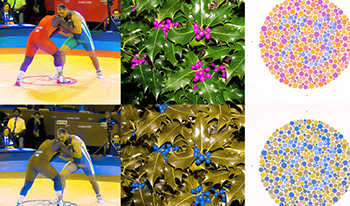References
1NeitzJ.NeitzM.2010The genetics of normal and defective color visionVision51633651633–5110.1016/j.visres.2010.12.002
2RigdenC.1999The Eye of the Beholder’ - Designing for Colour-Blind UsersBr. Telecommun. Eng.17262–6
3HansenE.Fargeblindhet20101st ed.Gyldendal Norsk Forlag ASOslo, Norway
4ValbergA.Lys Syn Farge19981st ed.Tapir ForlagChichester, England, United Kingdom
5FlatlaD.GutwinC.“‘So That’s What You See!”’ Building Understanding with Personalized Simulations of Colour Vision DeficiencyASSETS ’12: The Proc. 14th Int’l. ACM SIGACCESS Conf. on Computers and Accessibility2012Association for Computing Machinery (ACM)Boulder, Colorado, USA167174167–74
6HubelD. H.WieselT. N.1968Receptive fields and functional architecture of monkey striate cortexJ. Physiol.195215243215–4310.1113/jphysiol.1968.sp008455
7TreismanA. M.GeladeG.1980A feature-integration theory of attentionCogn. Psychol.129713697–13610.1016/0010-0285(80)90005-5
8Simon-LiedtkeJ.FarupI.Empirical Disadvantages for Color-Deficient PeopleMid-Term Meeting of the Int’l. Colour Association (AIC 2015)2015International Colour Association (AIC)Tokyo, Japan391394391–4
9ChangiziM. A.ZhangQ.ShimojoS.2006Bare skin, blood and the evolution of primate colour visionBiol. Lett.2217221217–2110.1098/rsbl.2006.0440
10BramãoI.FaíscaL.PeterssonK. M.ReisA.The Contribution of Color to Object RecognitionAdvances in Object Recognition Systems2012InTechRijeka, Croatia738873–88
11MilićN.NovakovićD.MilosavljevićB.Enhancement of image content for observers with colour vision deficienciesColor Image and Video Enhancement2015SpringerCham315343315–43
12HuangJ.-B.ChenC.-S.JenT.-C.WangS.-J.Image recolorization for the colorblindIEEE Int’l. Conf. on Acoustics, Speech and Signal Processing, 2009 (ICASSP 2009)2009IEEEPiscataway, NJ116111641161–4
13KuhnG. R.OliveiraM. M.FernandesL. A.2008An efficient naturalness-preserving image-recoloring method for dichromatsIEEE Trans. Vis. Comput. Graphics14174717541747–5410.1109/TVCG.2008.112
14MachadoG. M.OliveiraM. M.2010Real-time temporal-coherent color contrast enhancement for dichromatsComput. Graph. Forum29933942933–4210.1111/j.1467-8659.2009.01701.x
15KoteraH.Optimal daltonization by spectral shift for dichromatic visionProc. IS&T/SID CIC20: Twentieth Color and Imaging Conf.2012IS&TSpringfield, VA302308302–8
16AnagnostopoulosC.-N.TsekourasG.AnagnostopoulosI.KalloniatisC.Intelligent modification for the daltonization process of digitized paintingsProc. 5th Int’l. Conf. on Computer Vision SystemsMarch 2007Universität BielefeldBielefeld, Germany
17AlsamA.DrewM. S.Fast Colour2greyProc. IS&T/SID CIC16: Sixteenth Color Imaging Conf.2008IS&TSpringfield, VA342346342–6
18Di ZenzoS.1986A note on the gradient of a multi-imageComput. Vis. Graph. Image Process.33116125116–2510.1016/0734-189X(86)90223-9
19GoldsteinH.Classical MechanicsAddison-Wesley World Student Series1950Vol. 1Addison-WesleyReading, Mass
20TveitoA.LangtangenH. P.NielsenB. F.CaiX.Elements of Scientific Computing2010Vol. 7SpringerBerlin Heidelberg
21Simon-LiedtkeJ.HardebergJ. Y.Task-Based Accessibility Measurement of Daltonization Algorithms for Information Graphics12th Congress of the Int’l. Colour Association (AIC 2013)July 2013Int’l. Colour Assn. (AIC)Newcastle, UK108111108–11
22Simon-LiedtkeJ. T.FarupI.LaengB.2015Evaluating color deficiency simulation and daltonization methods through visual search and sample-to-match: SaMSEM and ViSDEMProc. SPIE9395939513939–513
23Simon-LiedtkeJ. T.FarupI.February 2016Evaluating color vision deficiency daltonization methods using a behavioral visual-search methodJ. Vis. Commun. Image Represent.35236247236–4710.1016/j.jvcir.2015.12.014
24ThurstoneL. L.July 1927A law of comparative judgmentPsychol. Rev.34273286273–8610.1037/h0070288
25EngeldrumP. G.Psychometric Scaling: A Toolkit for Imaging Systems Development2000Imcotek PressWinchester, MA, USA
26BrettelH.ViénotF.MollonJ. D.1997Computerized simulation of color appearance for dichromatsJ. Opt. Soc. Amer. A14264726552647–5510.1364/JOSAA.14.002647
27LindebergT.1994Scale-space theory: A basic tool for analyzing structures at different scalesJ. Appl. Stat.21225270225–7010.1080/757582976
28Simon-LiedtkeJ. T.FlatlaD.BakkenE. N.Checklist for Daltonization methods: Requirements and characteristics of a good recolouring methodIS&T Electronic Imaging: Color Imaging XXII: Displaying, Processing, Hardcopy, and Applications Proc.2017IS&TSpringfield, VA212721–7
29GonzalezR. C.WoodsR. E.Digital Image Processing20083rd ed.Pearson Education Inc.Upper Saddle River, NJ, USA
30ViénotF.BrettelH.MollonJ. D.1999Digital video colourmaps for checking the legibility of displays by dichromatsColor Res. Appl.24243252243–5210.1002/(SICI)1520-6378(199908)24:4<243::AID-COL5>3.0.CO;2-3
31LucassenM.AlferdinckJ.Dynamic simulation of color blindness for studying color vision requirements in practiceCGIV2006: 3rd European Conf. on Colour in Graphics, Imaging, and Vision2006IS&TSpringfield, VA355358355–8
32Simon-LiedtkeJ. T.FarupI.2016Using a behavioral match-to-sample method to evaluate color vision deficiency simulation methodsJ. Imaging Sci. Technol.6010.2352/J.ImagingSci.Technol.2016.60.5.050409
33JolliffeI.Principal Component Analysis2002SpringerBerlin, Heidelberg
34Simon-LiedtkeJ. T.FarupI.2015Spatial Intensity Channel Replacement Daltonization (SIChaRDa)Proc. SPIE9395939516939–516
35
36FarsiuS.EladM.MilanfarP.2006Multiframe demosaicing and super-resolution of color imagesIEEE Trans. Image Process.15141159141–5910.1109/TIP.2005.860336
37JähneB.Digital Image Processing20056th ed.Spinger-Verlag-Berlin-HeidelbergBerlin, Germany
38RudinL. I.OsherS.FatemiE.Nov. 1992Nonlinear total variation based noise removal algorithmsPhys. D60259268259–6810.1016/0167-2789(92)90242-F
39ChengA. H.-D.ChengD. T.2005Heritage and early history of the boundary element methodEng. Anal. Bound. Elem.29268302268–30210.1016/j.enganabound.2004.12.001
40SharmaG.Digital Color Imaging Handbook2002CRC Press, Inc.Boca Raton, FL, USA
41
42HardyL.RandG.RittlerM. C.1954HRR polychromatic platesJ. Opt. Soc. Am.44509521509–2110.1364/JOSA.44.000509
43NeitzJ.BaileyJ.H.R.R. Pseudoisochromatic Plates20024th ed.Richmond Products, Inc.Albuquerque, NM, USA
44KeelanB. W.UrabeH.2003ISO 20462: A psychophysical image quality measurement standardImage Qual. Syst. Perform.5294181189181–9
45WilsonE. B.1927Probable inference, the law of succession, and statistical inferenceJ. Am. Stat. Assoc.22209212209–1210.1080/01621459.1927.10502953
46LøvåsG. G.Statistikk for Universiteter Og Høgskoler20082nd ed.UniversitetsforlagetOslo, Norway
47MontagE. D.2006Empirical formula for creating error bars for the method of paired comparisonJ. Electron. Imaging15010502010–50210.1117/1.2181547
48PeirceJ.
49
50
51
52KovacJ.PeerP.SolinaF.2003Human skin color clustering for face detectionIEEE2
53BlomgrenP.ChanT. F.1998Color TV: Total Variation Methods for Restoration of Vector-Valued ImagesImage Process. IEEE Trans.7304309304–910.1109/83.661180
54SapiroG.Vector-valued active contoursProc. 1996 IEEE Computer Society Conf. on Computer Vision and Pattern Recognition (CVPR)1996IEEEPiscataway, NJ680685680–5
55SapiroG.1997Color snakesComput. Vis. Image Underst.68247253247–5310.1006/cviu.1997.0562
56PurvesD.LottoR. B.Why We See What We Do Redux: A Wholly Empirical Theory of Vision2011Sinauer Associates, Inc.Sunderland, Massachusetts, USA

 Find this author on Google Scholar
Find this author on Google Scholar Find this author on PubMed
Find this author on PubMed